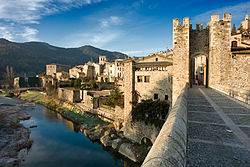
Terrassa is a city in central-eastern Catalonia (Spain). It is one of the two capitals of Vallès Occidental county, along with Sabadell.
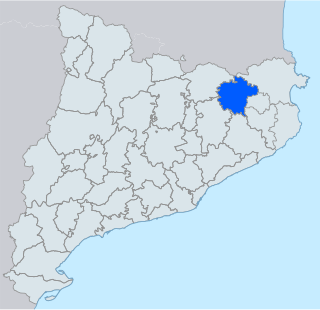
Garrotxa is a comarca (county) in the Girona region, Catalonia, Spain. Its population in 2016 was 55,999, more than half of them in the capital city of Olot. It is roughly equivalent to the historical County of Besalú.
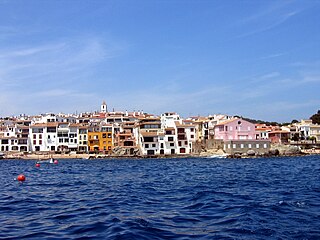
Palafrugell is a municipality in the Mediterranean Costa Brava, located near Palamós in the comarca of Baix Empordà, in the province of Girona, Catalonia, Spain. It is the largest city of its comarca, with 22,365 inhabitants. Several coastal and interior towns are frequently grouped with this city.

Sagàs is a small town and municipality located in Catalonia, in the comarca of Berguedà. It is located in the geographical area of the pre-Pyrenees.

The County of Besalú was one of the landlocked medieval Catalan counties near the Mediterranean coastline. It was roughly coterminous with the modern comarca of Garrotxa and at various times extended as far north as Corbières, Aude, now in France. Its capital was the village of Besalú. Throughout most of its history it was attached to one of the other more powerful counties, but it experienced a century of independence before it was finally and irrevocably annexed to the County of Barcelona.

Bassella is a municipality in the comarca of the Alt Urgell, in Catalonia, Spain. The village of Bassella, one of nine settlements which make up the municipality, is located at the confluence of the Segre river with the Salada river and at the point where the route from Solsona and the potash mines of Cardona meets the route between Lleida and La Seu d'Urgell. The ajuntament is located in Castellnou de Bassella.

Sant Feliu de Guíxols is a municipality in the comarca of the Baix Empordà in Catalonia, Spain. It is situated on the Costa Brava and is an important port and tourist centre. The district abuts to the north, the upmarket s'Agaró resort built round the Sant Pol Beach. In addition to tourism and the port the cork industry is a traditionally local industry. The town contains a large monastery which now houses the town museum and is a protected historico-artistic monument.

Sant Pere de Rodes is a former Benedictine monastery in the comarca of Alt Empordà, in the North East of Catalonia, Spain.

Maçanet de Cabrenys is a municipality in the comarca of Alt Empordà, Girona, Catalonia, Spain. It also belongs to the subcomarca of Alta Garrotxa. It includes the villages of Arnera, Les Creus, Les Mines, Les Salines, Tapis, Els Vilars, and Oliveda. It is situated at the foot of the Eastern Pyrenees, with the Rivers Arnera and Frausa. It has numerous springs, which makes it attractive for tourism, the largest source of revenue, together with dryland farming and animal husbandry. It has a water bottling facility.

Setcases is a municipality and town in the Pyrenean comarca of Ripollès in Girona, Catalonia, Spain, near the French border. The Ter River is born in the mountains just above Setcases. The current mayor is Jaume Busquets i Bartolí.

Torà is a town and municipality in the North East of the comarca (county) of Solsonès, in the province of Lleida, Catalonia, Spain. The urban structure of the center has retained most of its original design, with narrow, twisting streets and blocks formed by rows of attached buildings. The Medieval town grew around a castle or fortified place. A particular trait of the fortified origin of the town is the presence of a number of portals to allow several streets their pass through defensive barriers formed by the rows of buildings of the town and its walls. Torà is some 10 kilometers northeast from the more populated Guissona, a neighbor town that has experienced an important economic development in the last half century parallel to an unprecedented demographic growth sped up in the recent years.

Beuda is a Spanish municipality located in the comarca of Garrotxa, in the province of Girona, Catalonia, Spain. It is located on the slopes near the Mont massif, to the north of Besalú.
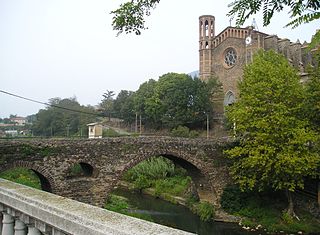
Sant Joan les Fonts is a municipality of the comarca of Garrotxa, located in Girona, Catalonia, northern Spain. As of 2014, the population is 2,919. Until 1949 it was known as Begudà.

Lluçà is a municipality in the comarca of Lluçanès in Catalonia, Spain. It is subdivided into the town of Santa Eulàlia de Puigoriol, and the much smaller village of Lluçà. This village, prominent because of its monastery, gives its name to the surrounding natural comarca of Lluçanès.
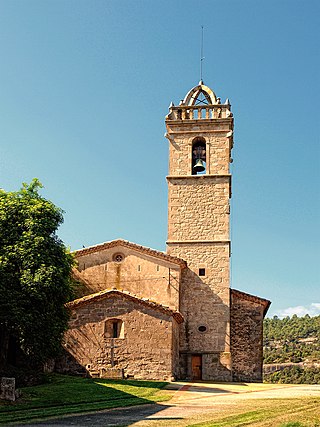
Viver i Serrateix is a municipality in the comarca of Berguedà, Catalonia. It comprises the towns of Viver and Serrateix, as per the name.
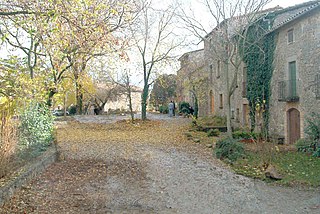
Montclar is a municipality in the comarca of Berguedà, Catalonia. The municipality includes an exclave to the north-east.

Sant Joan de les Abadesses is a town and municipality located in the south-east of the comarca of Ripollès, in the province of Girona, Catalonia, Spain.

La Vall de Bianya is a municipality of the comarca of Garrotxa, Catalonia. It is formed by eleven villages scattered around the Bianya and Bac valleys. The seat of the municipal government is in L'Hostalnou de Bianya, and the village with more inhabitants is La Canya. This latter village is divided between the municipalities of La Vall de Bianya and Sant Joan les Fonts. The municipality is part of the Zona Volcànica de la Garrotxa Natural Park and the Alta Garrotxa Consortium.
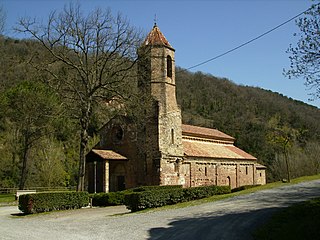
Sant Joan les Fonts is a Benedictine monastery in Sant Joan les Fonts, Garrotxa comarca, Catalonia, Spain. In 1079, the church was owned by the viscounts of Besalu. They gave it to the abbey to abbey of St. Victor of Marseille, who founded a Benedictine priory. It was subordinate to Sant Pere de Besalú until 1592, and to Sant Pere de Camprodón until 1835.

Sant Pere de Besalú is a Benedictine monastery in Besalú, Garrotxa, Catalonia, Spain. The building was renovated in 1160.
